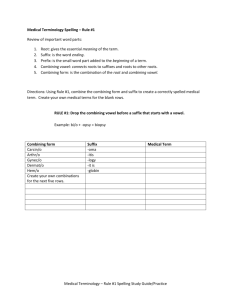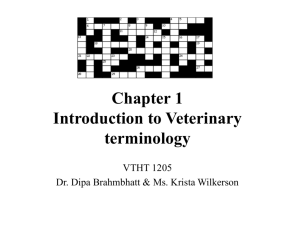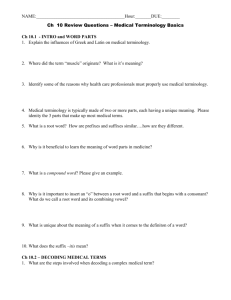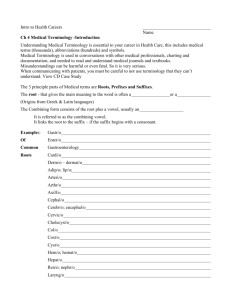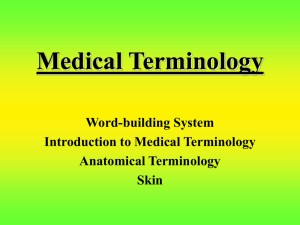For the power point on Medical Terminology Click here
advertisement
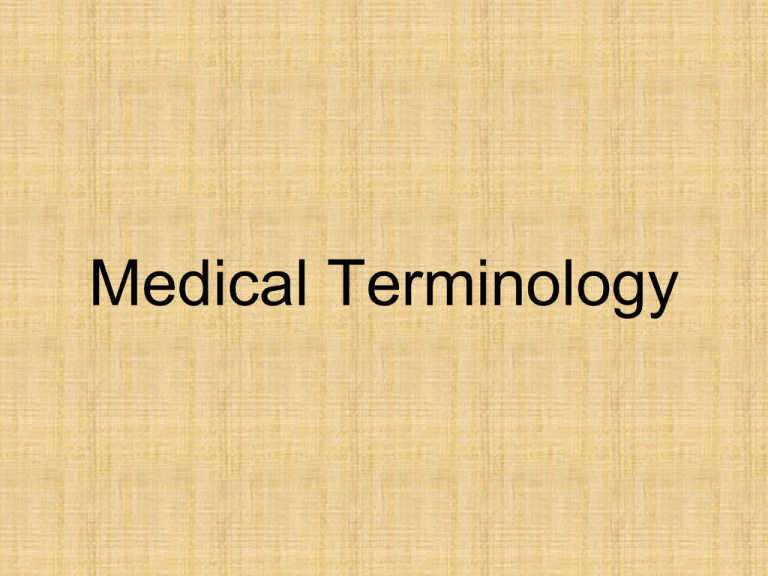
Medical Terminology Objectives • Upon completion of this unit you will be able to: – Identify and define the four word parts – Identify and define a combining form – Analyze and define medical terms – Build medical terms for given definitions • Mrs. Jones is a 60 y/o admitted thru ER c abdominal pain in the RLQ. CXR, EKG, CBC and ABG’s were done stat. It was decided to perform an exploratory laparotomy, but suspects she will end up needing a bilateral salpingoophorectomy. • pneumonultramicroscopicsilicovolcanonconiosis Origins of medical language • Current medical vocabulary includes terms built from Greek and Latin word parts, some which were used by Hippocrates and Aristotle over 2000 years ago Word Parts / Building Blocks • Medical terms are built from word parts with some or all of the following components: • Word roots • Suffixes • Prefixes • Combining vowels • Combining forms Word Root • The word root is the foundation of the word • Usually indicates the part of the body involved • All medical terms must have one or more word roots Examples: • In the word…………………..play/er (play is the word root) • In the medical term …………arthr/itis arthr (which means joint) is the word root • In the medical term………….hepat/it is hepat (which means liver) is the word root Suffixes • Suffix is the word part attached to the end of the word root to modify its meaning. • The suffix usually indicates the procedure, disease, or condition • All medical terms must have a suffix. Examples: • In the medical term…………..hepat/ic -ic (which means pertaining to) is the suffix The term hepatic means pertaining to the liver • In the medical term ………… hepat/itis -itis (which means inflammation) is the suffix The term hepatitis means inflammation of the liver (inflammation being a condition) Prefix • The prefix is a word part that is attached to the beginning of the word root to modify its meaning. • It usually indicates location, time, color, or number • Not all medical terms have prefixes Examples: • In the word ………………...re/play re- is the prefix • In the medical term ………sub /hepat /ic sub- (which means under) The medical term subhepatic means pertaining to under the liver Combining Vowel • It links the root to the suffix or the root to another root • The combining vowel is usually an “O” • A combining vowel has no meaning of its own. It just joins word parts and makes them easier to pronounce Combining vowels • Guideline #1: – When connecting a root and a suffix a combining vowel is used unless the suffix begins with a vowel • Guideline #2: – When connecting two word roots, a combining vowel is usually used even if vowels are present at the junction Exercise 1: • True or False Complete the phrases with the correct word part: 6. There is always a prefix at the beginning of a medical term 7. A combining vowel is always used when connecting a word root and a suffix 8. A prefix modifies the meaning of the word 9. A combining vowel is used to ease pronunciation 10. “I” is the most commonly used combing vowel 11. The word root is the core of a medical term 12. A combining vowel is used between a prefix and word root 13. A combining form is a word part 1. A __ is attached at the beginning of a word root 2. ___ are usually an “o” 3. All medical terms contain one or more ___ 4. A ____is attached at the end of a word root. 5. The ______ _____ is the word root with the combining vowel attached Analyzing and defining Medical Terms osteoarthropathy To analyze a medical term divide it into word parts, label each word parts, and label the combining forms. Divide the word with slashes: oste / o/ arthr / o/ pathy Label each word part by using the following abbreviations: WR WORD ROOT P PREFIX S SUFFIX CV COMBINING VOWEL Example of dividing and labeling: WR CV WR CV S Oste / o / arthr /o / pathy CF CF Putting it together! • To define medical terms apply the meaning of each word part in the term. • Begin by defining the suffix, then move to the beginning of the term to complete the definition Fundamental rules for combining word parts Word part Abbr. Definition Root wr Gives essential meaning to the word Usually body part involved Suffix s is the word ending Usually indicates, disease, procedure, or condition Prefix p Added to the beginning. Usually indicates times, number, color, position Combing vowel cv Connects roots to suffixes and root to other roots to make pronunciation easier Combining form Is the combination of the root and combining vowel cf Root words • Acr/o - extremities • angi/o - vessel • arthr/o – joint Common Medical Root Words • cardi/o – heart • cephal/o – head • col/o - colon • cost/o – ribs • crani/o - skull • cyst/o – sac containing fluid urinary bladder • derm/o, dermat/o, cutane – skin • enter/o - intestines • gastr/o - stomach • hem/o – blood hemat/o • hepat/o - liver • my/o – muscle • nephr/o, ren/o – kidney • neur/o – nerve • or/o - mouth • oste/o - bone • ot/o – ear • pneum/o • pulmon/o, - Lung • psych/o -mind • rhin/o – nose • splen/o – spleen • thorac/o - chest Colors • cyan/o • erythr/o • leuk/o • melan/o • xanth/o blue red white black yellow Common Medical Suffixes • • • • • • • • -ac, -al, -ic -algia -ectomy -itis -malacia -megaly -ology -ologist pertaining to pain surgical removal inflammation softening enlargement the study of specialist Common Medical Suffixes • • • • • -oid -osis -otomy -pathy -scope • -oma -like, resembling - abnormal condition - cut into – disease - instrument to visually examine -tumor Common Medical Prefixes • • • • • • • • • • aabadanteantiauto dysdorsendoepi- absence of; without away from toward, in the direction of before against self difficult, painful back within above, upon Common Medical Prefixes (cont.) • • • • • • • • • • hemihyperhypointerintramacromal – micro peri poly- half over, above, increased below, under, decreased between, among within, inside large bad small surrounding, around many Common Medical Prefixes • post • sub• super• tachy - after under, less, below above, excessive, beyond fast (stop here) Common Medical Abbreviations • • • • • • • c – with s – without a – before p – after po – by mouth prn – as needed NPO – nothing by mouth Common medical Abreviations • ASAP – as soon as possible • ABG’s - arterial blood gases • ac – before meals • amb – ambulate or to walk • BP – blood pressure • BS – blood sugar • CBC – complete blood count • c/o – complaining of • CXR – chest x-ray Common Medical Abbreviations • • • • • • DNR – do not resuscitate EKG – electrocardiogram ER - emergency room GI – gastrointestinal ICU – intensive care unit PACU – post-anesthesia care unit • PT - physical therapy • Pt - patient • SOB – shortness of breath • VS – vital signs • W/C – wheel chair • wnl - within normal limits • y/o – year old Common Medical Abbreviations • stat – immediately • IV – intravenous (within a vein) • q.d. – every day • b.i.d. – two times a day • t.i.d. – three times a day • q.i.d – four times a day • Rx – prescription • Tx - treatment Common Medical Abbreviations • Male • female Communication Connection • A medication is to be taken once every day (q.d.), but a health care provider mistakenly writes q.i.d. on the prescription. What will be the result of writing the incorrect abbreviation? • A 76 y/o__ admitted amb. into the ER. c/o SOB and appears to be cyanotic. Tests ordered: ABG’s, CBC, CXR, and EKG STAT. IV started with 18 gauge butterfly infusing D5W at 20 gtts/min. VS wnl. Pt. to be sent to ICU per w/c ASAP. RX of Lanoxin 25 mg to be given po c meals qd
